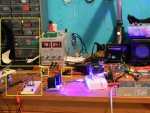ARG
0
- Joined
- Feb 27, 2011
- Messages
- 6,772
- Points
- 113
I am having some issues with my LPM's. I own a LaserBee 3.2W and an Ophir 20c head.
I have an M140 in an Al block with a TEC to chill it and a CPU heatsink w/fan for the top side of the heatsink. The Ophir and LaserBee's sensor area's are level, and when the Ophir is in use, it is perfectly centred.

The PCB on the left has a circuit to take the 9V battery also seen on the left to -9V and +9V. The supply is very clean from what I can see on the scope.
My problem is that my LaserBee's readings are VERY different from my Ophir readings.

This is a reading from the LaserBee. At 50 seconds I turn on the TEC and CPU heatsink fan from the power supply seen on the right of the first picture. As you can see, the reading is all over the place on what I assumed to be a stable laser.
When I measure this with my Ophir the readings (from my FLUKE DMM) are +/-1mW without the TEC and 100% stable with the TEC after 5 minutes to equalize. No massive change as seen in the LaserBee Graph.
What is causing this huge difference in readings? I thought the Ophir would have shown more instability in the laser since the response time is faster.
The fan is very very slow, and the air is sucked in from the top and comes out the sides perpendicular to the sensors, so it is not that.
My best guess is noise from the PSU when I turn it on, but would it cause that monster of a graph? I added an RF choke to the TEC cord with a couple of turns around it and it didn't seem to have an effect.
I have an M140 in an Al block with a TEC to chill it and a CPU heatsink w/fan for the top side of the heatsink. The Ophir and LaserBee's sensor area's are level, and when the Ophir is in use, it is perfectly centred.

The PCB on the left has a circuit to take the 9V battery also seen on the left to -9V and +9V. The supply is very clean from what I can see on the scope.
My problem is that my LaserBee's readings are VERY different from my Ophir readings.

This is a reading from the LaserBee. At 50 seconds I turn on the TEC and CPU heatsink fan from the power supply seen on the right of the first picture. As you can see, the reading is all over the place on what I assumed to be a stable laser.
When I measure this with my Ophir the readings (from my FLUKE DMM) are +/-1mW without the TEC and 100% stable with the TEC after 5 minutes to equalize. No massive change as seen in the LaserBee Graph.
What is causing this huge difference in readings? I thought the Ophir would have shown more instability in the laser since the response time is faster.
The fan is very very slow, and the air is sucked in from the top and comes out the sides perpendicular to the sensors, so it is not that.
My best guess is noise from the PSU when I turn it on, but would it cause that monster of a graph? I added an RF choke to the TEC cord with a couple of turns around it and it didn't seem to have an effect.




